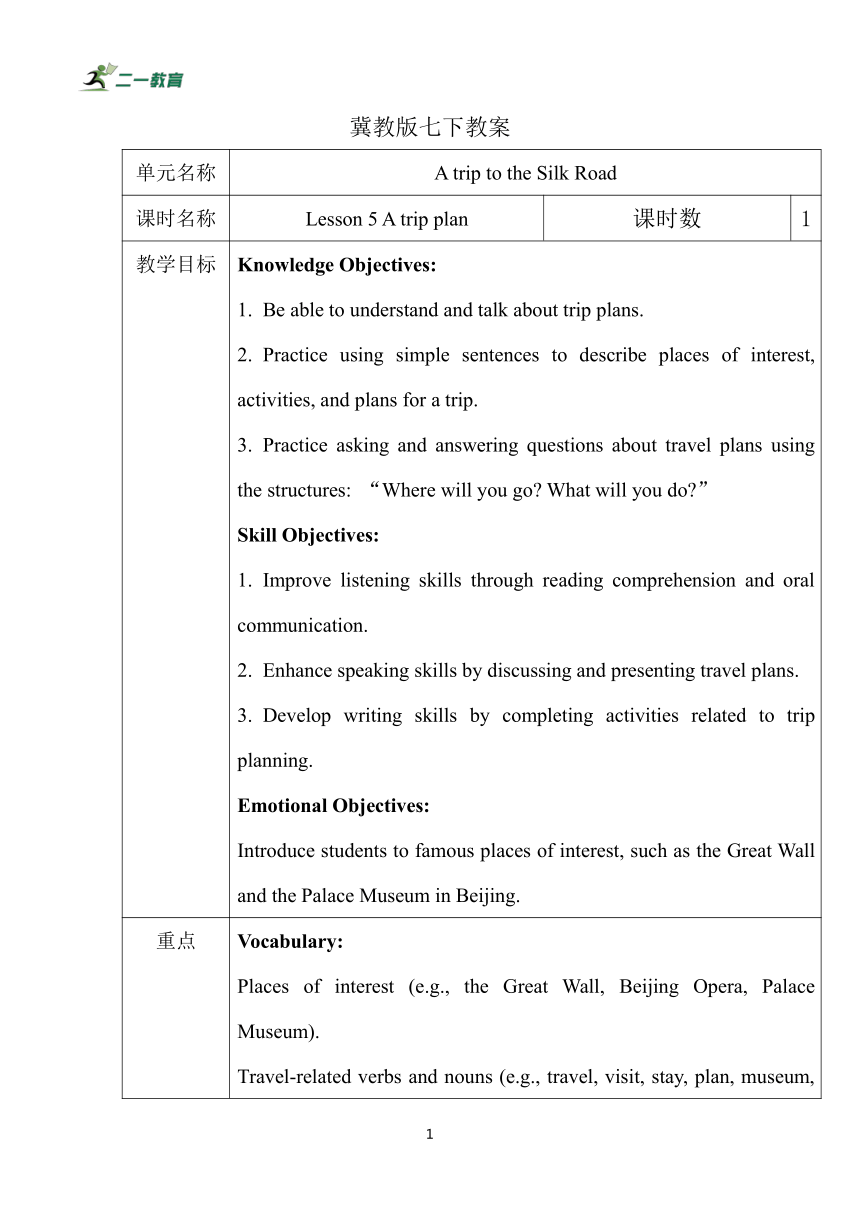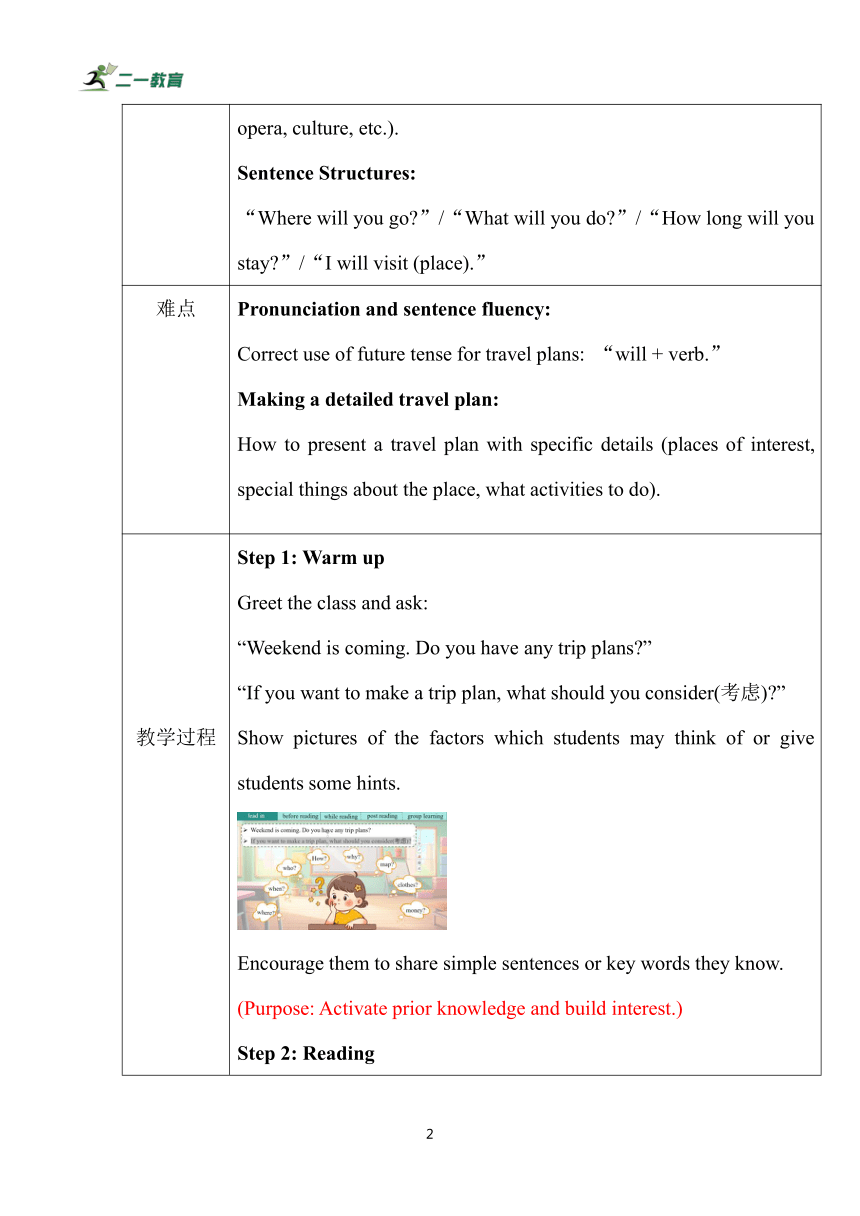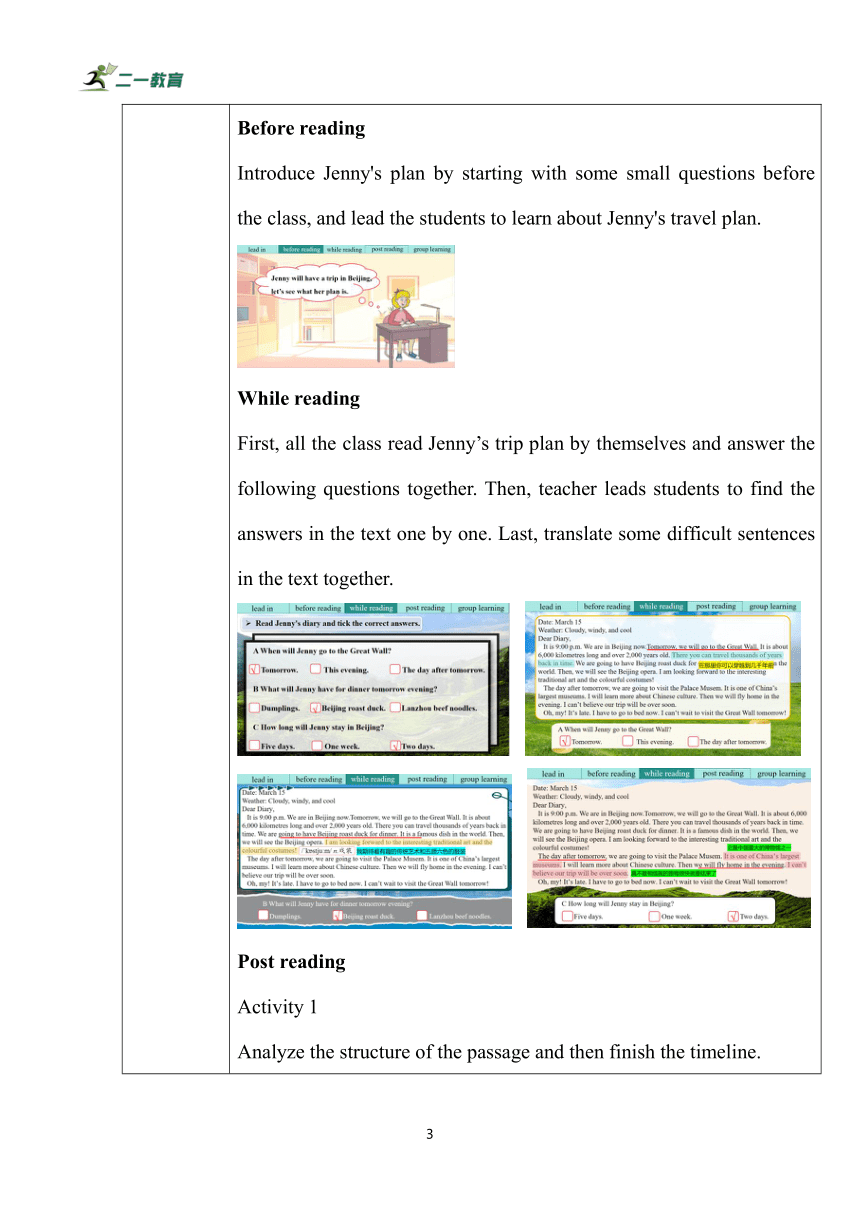Unit 1 Lesson 5 A trip to the Silk Road教案-新冀教(2024)七下
文档属性
| 名称 | Unit 1 Lesson 5 A trip to the Silk Road教案-新冀教(2024)七下 |  | |
| 格式 | docx | ||
| 文件大小 | 2.3MB | ||
| 资源类型 | 试卷 | ||
| 版本资源 | 冀教版 | ||
| 科目 | 英语 | ||
| 更新时间 | 2025-01-20 11:25:38 | ||
图片预览



文档简介
冀教版七下教案
单元名称 A trip to the Silk Road
课时名称 Lesson 5 A trip plan 课时数 1
教学目标 Knowledge Objectives: Be able to understand and talk about trip plans. Practice using simple sentences to describe places of interest, activities, and plans for a trip. Practice asking and answering questions about travel plans using the structures: “Where will you go What will you do ” Skill Objectives: Improve listening skills through reading comprehension and oral communication. Enhance speaking skills by discussing and presenting travel plans. Develop writing skills by completing activities related to trip planning. Emotional Objectives: Introduce students to famous places of interest, such as the Great Wall and the Palace Museum in Beijing.
重点 Vocabulary: Places of interest (e.g., the Great Wall, Beijing Opera, Palace Museum). Travel-related verbs and nouns (e.g., travel, visit, stay, plan, museum, opera, culture, etc.). Sentence Structures: “Where will you go ”/“What will you do ”/“How long will you stay ”/“I will visit (place).”
难点 Pronunciation and sentence fluency: Correct use of future tense for travel plans: “will + verb.” Making a detailed travel plan: How to present a travel plan with specific details (places of interest, special things about the place, what activities to do).
教学过程 Step 1: Warm up Greet the class and ask: “Weekend is coming. Do you have any trip plans ” “If you want to make a trip plan, what should you consider(考虑) ” Show pictures of the factors which students may think of or give students some hints. Encourage them to share simple sentences or key words they know. (Purpose: Activate prior knowledge and build interest.) Step 2: Reading Before reading Introduce Jenny's plan by starting with some small questions before the class, and lead the students to learn about Jenny's travel plan. While reading First, all the class read Jenny’s trip plan by themselves and answer the following questions together. Then, teacher leads students to find the answers in the text one by one. Last, translate some difficult sentences in the text together. Post reading Activity 1 Analyze the structure of the passage and then finish the timeline. (Purpose: Enhance reading comprehension and learn the writing methods of trip plan from the passage.) Activity 2 After analyze Jenny’s trip plan, students need to think about by themselves, is it a reasonable plan If not, what advice could they give (Purpose: Enhance reading comprehension and cultivate students' critical thinking and the ability to think in English, and enable students to solve practical problems in life using English.) Activity 3 Create a scenario to guide students to solve practical problems around them in English. A Where will you travel B When will you go on your trip C Who will travel with you D What places of interest will you visit E What is special about them (Purpose: Learning some similar expressions from the article and applying them to our daily lives, and using English expressions to think about and solve problems. This is one of the abilities we aim to cultivate in this class. ) Step 3: group learning Activity 1 Create a situation for students and try to think about the practical problems in real life. (Purpose: Enhance speaking skills and boost confidence in using English in real-life contexts.) Activity 2 Four students a group, design a trip plan for themselves and finish the chart. Step 4 Summary Step 5 Exercises Finish the exercises on PPT. Step 6 Homework Basic Homework Find the sentences related to the description of scenic spots in the article and organize them in chronological order in your notebook. Practical Homework Suppose you are Jenny. Based on the content of the article, write an email to your friend, introducing your travel plan to Beijing. The email should be no less than 50 words. Extended Homework Look up information to learn more about the famous scenic spots and characteristic cultures of Beijing. Then write a short introduction in English, with no less than 80 words. You can introduce the history, features of the scenic spots, and why you want to visit them.
板书设计
教学反思 What Went Well: Students were highly engaged in creating their own trip plans and enjoyed sharing with the class. The vocabulary related to travel was understood and used effectively during the lesson. Areas for Improvement: Some students had difficulty with sentence fluency, particularly with the future tense. More individual practice could help students feel more confident with speaking in complete sentences. Suggestions for Future Lessons: Include more interactive activities like role plays to simulate real-life situations for better practical application. Provide additional opportunities for listening and speaking practice to increase fluency.
单元名称 A trip to the Silk Road
课时名称 Lesson 5 A trip plan 课时数 1
教学目标 Knowledge Objectives: Be able to understand and talk about trip plans. Practice using simple sentences to describe places of interest, activities, and plans for a trip. Practice asking and answering questions about travel plans using the structures: “Where will you go What will you do ” Skill Objectives: Improve listening skills through reading comprehension and oral communication. Enhance speaking skills by discussing and presenting travel plans. Develop writing skills by completing activities related to trip planning. Emotional Objectives: Introduce students to famous places of interest, such as the Great Wall and the Palace Museum in Beijing.
重点 Vocabulary: Places of interest (e.g., the Great Wall, Beijing Opera, Palace Museum). Travel-related verbs and nouns (e.g., travel, visit, stay, plan, museum, opera, culture, etc.). Sentence Structures: “Where will you go ”/“What will you do ”/“How long will you stay ”/“I will visit (place).”
难点 Pronunciation and sentence fluency: Correct use of future tense for travel plans: “will + verb.” Making a detailed travel plan: How to present a travel plan with specific details (places of interest, special things about the place, what activities to do).
教学过程 Step 1: Warm up Greet the class and ask: “Weekend is coming. Do you have any trip plans ” “If you want to make a trip plan, what should you consider(考虑) ” Show pictures of the factors which students may think of or give students some hints. Encourage them to share simple sentences or key words they know. (Purpose: Activate prior knowledge and build interest.) Step 2: Reading Before reading Introduce Jenny's plan by starting with some small questions before the class, and lead the students to learn about Jenny's travel plan. While reading First, all the class read Jenny’s trip plan by themselves and answer the following questions together. Then, teacher leads students to find the answers in the text one by one. Last, translate some difficult sentences in the text together. Post reading Activity 1 Analyze the structure of the passage and then finish the timeline. (Purpose: Enhance reading comprehension and learn the writing methods of trip plan from the passage.) Activity 2 After analyze Jenny’s trip plan, students need to think about by themselves, is it a reasonable plan If not, what advice could they give (Purpose: Enhance reading comprehension and cultivate students' critical thinking and the ability to think in English, and enable students to solve practical problems in life using English.) Activity 3 Create a scenario to guide students to solve practical problems around them in English. A Where will you travel B When will you go on your trip C Who will travel with you D What places of interest will you visit E What is special about them (Purpose: Learning some similar expressions from the article and applying them to our daily lives, and using English expressions to think about and solve problems. This is one of the abilities we aim to cultivate in this class. ) Step 3: group learning Activity 1 Create a situation for students and try to think about the practical problems in real life. (Purpose: Enhance speaking skills and boost confidence in using English in real-life contexts.) Activity 2 Four students a group, design a trip plan for themselves and finish the chart. Step 4 Summary Step 5 Exercises Finish the exercises on PPT. Step 6 Homework Basic Homework Find the sentences related to the description of scenic spots in the article and organize them in chronological order in your notebook. Practical Homework Suppose you are Jenny. Based on the content of the article, write an email to your friend, introducing your travel plan to Beijing. The email should be no less than 50 words. Extended Homework Look up information to learn more about the famous scenic spots and characteristic cultures of Beijing. Then write a short introduction in English, with no less than 80 words. You can introduce the history, features of the scenic spots, and why you want to visit them.
板书设计
教学反思 What Went Well: Students were highly engaged in creating their own trip plans and enjoyed sharing with the class. The vocabulary related to travel was understood and used effectively during the lesson. Areas for Improvement: Some students had difficulty with sentence fluency, particularly with the future tense. More individual practice could help students feel more confident with speaking in complete sentences. Suggestions for Future Lessons: Include more interactive activities like role plays to simulate real-life situations for better practical application. Provide additional opportunities for listening and speaking practice to increase fluency.
同课章节目录
